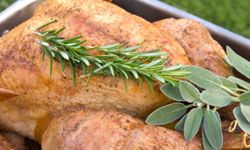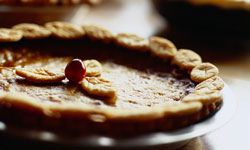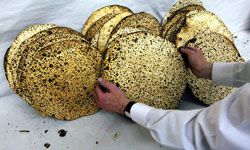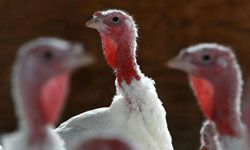
During the holidays, families and friends tend to gather in one place -- around the dining room table. We catch up on each other's lives, toast the holiday with a clink of our glasses and then eat ourselves into a food coma.
With holidays come traditions -- dyeing Easter eggs, exchanging wrapped gifts, lighting the menorah -- and many of our holiday traditions center around food. Think about it. What's Thanksgiving without a turkey? Or St. Patrick's Day without corned beef?
Advertisem*nt
Have you ever wondered why we eat certain foods on certain holidays? Keep reading to find out the stories behind 10 classic holiday foods. Now you'll have something else to talk about at the table -- instead of poor old Aunt Gladys and her 20 cats.
Contents
- Roast Goose
- Pumpkin Pie
- Green Bean Casserole
- Corned Beef and Cabbage
- Collard Greens and Black-eyed Peas
- Latkes
- Eggnog
- Matzah
- Ham
- Turkey
10. Roast Goose
Although most of us carnivores enjoy a turkey during the holidays, the traditional main dish is actually a roast goose. Feasting on goose was an important part of many ancient celebrations and rituals. Because geese are migratory, they would disappear and reappear during certain times of the year -- usually around harvest time and change of seasons. Families typically served roast goose to celebrate the winter solstice. Later, in Victorian times, it became synonymous with Christmas. For many generations of Eastern European Jews, goose was also a favorite during the Hanukkah holiday.
Just like turkey or chicken, goose is a white meat. However, its breast meat is darker than a chicken or turkey breast, with a stronger flavor. That's because geese can fly and have more developed breast muscles, while turkeys and chickens don't exercise their wings as much.
Advertisem*nt
Over the decades, goose seems to have fallen out of favor. The average American consumes about one-third of a pound of goose each year. Compare that to turkey -- 17.5 pounds (7.9 kilograms) per person per year.
9. Pumpkin Pie

Pumpkin pie is a real classic. Its rustic orange color and sweet, earthy taste makes it a favorite for fall celebrations. Historians believe the first pumpkin pies -- or at least a forerunner to pumpkin pie -- were made by American settlers at Plymouth. The Native Americans showed them many uses for pumpkin. More like a custard than actual pie, Pilgrims filled a hollowed out pumpkin with milk, honey and spices, baking it in hot ashes on the fire.
In 1796, Amelia Simmons wrote the first cookbook ever created and published completely in America. This cookbook, "American Cookery," featured probably the first real pumpkin pie recipe -- though she called it "pumpkin pudding."
Advertisem*nt
Although you can make a pumpkin pie from scratch, many people choose to utilize canned pumpkin for the task. Canned pumpkin appeared on grocery shelves starting in 1929, and remains a pantry staple to this day.
8. Green Bean Casserole
Some dishes aren't just a tradition, they're a cultural touchstone. Green bean casserole is perhaps the ultimate piece of Americana. Campbell's® Cream of Mushroom Soup, green beans and french fried onions -- baked in a casserole -- make up this ubiquitous holiday side dish.
Dorcas Reilly invented the recipe in 1955, while working in the home economics department at Campbell Soup Company. Her inspiration came from two things Americans almost always had in their kitchens during the '50s -- green beans and mushroom soup. The entire recipe contains only five ingredients and is quick and easy to put together. A hit recipe was born.
Advertisem*nt
Each Thanksgiving, 20 to 30 percent of all U.S. households serve green bean casserole. That's more than 17 million homes!
Did You Know?
The original 8 by 11 recipe card for green bean casserole now resides in the Inventor's Hall of Fame, alongside Thomas Edison's light bulb.
7. Corned Beef and Cabbage

Before you start hitting the Guinness or Jameson's this St. Patrick's Day, sit down for a hearty meal. Look around at just about any restaurant in America on March 17th, and chances are, you'll see corned beef and cabbage on the menu. It's the most typical of Irish foods, right?
Actually, even though it's wildly popular holiday fare in the United States, corned beef and cabbage isn't all that popular in Ireland. Originally a dish for peasants, it just doesn't provide much excitement for native Irish.
Advertisem*nt
Corned beef is simply beef preserved in a salty brine. The term "corn" comes from the coarse salt grains used to cure the meat. Corning was extremely important before the days of refrigeration. Farmers slaughtered and corned the beef before winter. Then, to break the Lenten fast, they would serve the corned beef with a fresh spring cabbage on Easter Sunday.
6. Collard Greens and Black-eyed Peas
Looking for good luck in the coming year? Try dining on collard greens and black-eyed peas on New Year's.
According to Southern folklore, eating these foods on New Year'sDaywill bring luck and prosperity. The peas supposedly represent coins and the greens represent paper money. Some families place a penny in the pot while preparing the meal, and whoever ends up with the penny in his or her bowl will have good fortune all year. People also say that collard greens and black-eyed peas are "humble" foods. So, if you start off the year on a humble note, you'll find prosperity.
Advertisem*nt
The tradition of eating peas at the start of a new year goes back to the Civil War. Soldiers ravaged the countryside in search of food, but left the black-eyed peas behind, mistakenly believing them to be cattle feed. The local folks felt lucky that they themselves still had food.
Did You Know?
Other lucky New Year's foods include grapes, pork, fish and cakes.
5. Latkes

Latkes are potato pancakes -- small cakes of grated potatoes fried in olive oil. But their story is much more interesting than that. Latkes are a vital culinary part of any Hanukkah celebration.
The eight-day festival of Hanukkah commemorates the Miracle of Oil -- honoring a flame that miraculously burned for eight days. To celebrate, Jews all over the world eat foods fried in olive oil. Hanukkah falls at the end of the oil-pressing season, so olive oil was always readily available.
Advertisem*nt
Nobody is exactly sure why latkes ended up as the traditional food for this holiday. However, most traditions have modest beginnings. Potatoes were cheap and usually the only food in the root cellar during cold winters.
4. Eggnog
Talk about a classic holiday food. Have you ever had eggnog in September or March? You can't even find it on the grocery store shelves if it's not the Christmas season.
The literal meaning of eggnog is "egg inside a small cup." It's a drink traditionally served at holiday get-togethers and is typically alcoholic (although you can make or purchase nonalcoholic versions). The rich beverage contains eggs, sugar, milk and some sort of alcohol.
Advertisem*nt
Eggnog evolved from a hot British drink known as "posset," consisting of eggs, milk and ale or wine. Depending on the locale, the alcohol in the drink varies. In the South, most people drink their eggnog with bourbon. In other places, you might find eggnog with rum or brandy.
Today it's so ubiquitous, you can find all sorts of eggnog -- dairy-free, soy-based, fat-free, you name it.
Did You Know?
Legend has it that George Washington had his own recipe for egg nog that contained rye whiskey, rum and sherry. Quite a dose of holiday cheer!
3. Matzah

Matzah is a crackerlike, unleavened bread that Jews eat during Passover instead of regular bread. It's made with dough that never had a chance to rise. The Torah dictates that Jews may not eat leavened bread during the Passover holiday.
As the story goes, the tradition comes from a time when Jews were slaves in Egypt. When they followed God out into the desert, they only had time to bring simple dough that didn't have time to rise. Matzah is also known as "poor man's bread." So today's Jews eat matzah during Passover to commemorate the past exodus and remind themselves of faith and humility.
Advertisem*nt
You can also grind up matzah to make meal, often used as a substitute for flour in Passover cooking. That's how you get the matzah for matzah ball soup.
2. Ham
On the Christian Easter holiday, ham is the traditional centerpiece of the Easter Sunday dinner table. The reason behind this is simple.
Ham is pork, salted and cured. Back before the days of refrigeration, meat needed curing before storage. Pork was typically slaughtered in the fall and took until spring to fully cure. Thus, ham ended up being the main course for Easter dinners, a holiday that typically heralds the arrival of spring and general rebirth.
Advertisem*nt
Many Christians fast during the time of Lent, many times forgoing meat. Easter marks the end of Lent -- another reason to celebrate by eating meat.
Did You Know?
The origins of the Easter Bunny likely came from the German story of an egg-laying hare called "Oschter Haws." Children made nests where the hare could lay its colored eggs.
1. Turkey

It doesn't get much more traditional than a Thanksgiving turkey. Nearly 90 percent of Americans eat turkey as the main course on the Thanksgiving holiday.
Even though turkeys were native to the New World, turkey was quite popular for British holiday meals. Early explorers brought turkeys back to Europe after discovering them in the Americas. Therefore, it's not surprising that when early American settlers sat down to enjoy a feast, they chose turkey as their main course.
Scholars aren't sure that the Pilgrims even ate turkey at the first Thanksgiving in Plymouth. Records show they ate "wild fowl," but that could also mean goose or duck. However, since turkeys are native to North America, they quickly caught on as a traditional Thanksgiving bird. It doesn't hurt that turkeys are much bigger than chickens, too -- so one turkey can feed a lot of hungry people.
Lots More Information
Related HowStuffWorks Articles
- 10 Healthiest School Lunch Plans
- 10 Quirky Facts About Mass-produced Food
- 10 Reasons You Should Have Lemons in Your Fridge
- 10 Meals to Make From Leftovers
- 5 Tips for Baking the Perfect Cookie
Sources
- Abisch, Barry. "A Holiday Helping of Tradition: Roast Goose." WKOWTV.com. 2009. (Sept. 18, 2009) http://www.wkowtv.com/Global/story.asp?S=7487103
- Armstrong, Marcia. "This pea stands for prosperity for many PEAS IN HISTORY FUN FACTS." Fredericksburg.com. Dec. 26, 2007. (Sept. 18, 2009) http://fredericksburg.com/News/FLS/2007/122007/12262007/343185
- Cameron, Meaghan. "6 Easter Traditions Explained." Reader's Digest. 2009. (Sept. 18, 2009) http://www.rd.com/content/printContent.do?contentId=127877&KeepThis=true&TB_iframe=true&height=500&width=790&modal=true
- Chein, Shlomo. "Why do we eat Matzah on Passover?" AskMoses.com. 2009. (Sept. 18, 2009)http://www.askmoses.com/en/article/168,2193473/Why-do-we-eat-Matzah-on-Passover.html
- "Christmas Foods." The Food Timeline. Nov. 30, 2008. (Sept. 18, 2009) http://www.foodtimeline.org/christmasfood.html
- "Dorcas Reilly: the Creator of the Green Bean Casserole." Campbell's Kitchen. 2009. (Sept. 18, 2009) http://www.campbellkitchen.com/SpecialtyHolidayDorcasReilly.aspx?specialty=holiday
- "Easter Symbols." History.com. 2008. (Sept. 18, 2009) http://www.history.com/content/easter/easter-symbols
- Glazer, Phyllis. "Latkes: The soul of Hanukkah culinary tradition." Los Angeles Times. Dec. 17, 2008. (Sept. 18, 2009) http://www.latimes.com/features/printedition/food/la-fo-hanukkah17-2008dec17,0,2644591.story
- Johnson, Melissa. "Black-eyed pea tradition dates back to 1800s." Seguin Gazette-Enterprise. Dec. 31, 2006. (Sept. 18, 2009) http://www.seguingazette.com/story.lasso?ewcd=50a6990df9b8c858
- "Libby's Pumpkin History." VeryBestBaking.com. 2009. (Sept. 18, 2009) http://www.verybestbaking.com/products/libbys/history.aspx
- Salkeld, Lauren. "Lucky Foods for the New Year." Epicurious. 2009. (Sept. 18, 2009) http://www.epicurious.com/articlesguides/holidays/newyearsday/luckyfoods
- Stradley, Linda. "History of Pumpkin Pie." What's Cooking America. 2004. (Sept. 18, 2009) http://whatscookingamerica.net/History/PieHistory/PumpkinPie.htm
- Steintrager, Megan. "The Ultimate Corned Beef and Cabbage." Epicurious. 2009. (Sept. 18, 2009) http://www.epicurious.com/articlesguides/holidays/stpatricks/corned_beef_and_cabbage_recipe
- Taylor, Rod. "Campbell's Family Tradition." Promo. Nov. 1, 2003. (Sept. 18, 2009) http://promomagazine.com/campaigns/marketing_campbells_family_tradition/
- "The History of Egg Nog." Food History. Nov. 6, 2005. (Sept. 18, 2009) http://www.kitchenproject.com/history/eggnoghistory.htm
- Trex, Ethan. "Why We Eat What We Eat on Thanksgiving." mental_floss. Nov. 25, 2008. (Sept. 18, 2009) http://www.mentalfloss.com/blogs/archives/20498
- "Turkey History and Trivia." National Turkey Federation. 2009. (Sept. 18, 2009) http://www.eatturkey.com/consumer/history/history.html
Cite This!
Please copy/paste the following text to properly cite this HowStuffWorks.com article:
Citation